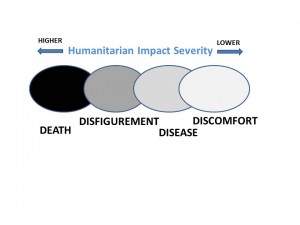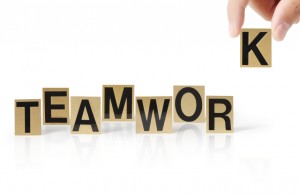At Give A Billion, we promote 3 steps to help overcome more poverty sooner, with the same or less resources. These are: Define poverty; Map poverty; and Focus the fixers. Central to poverty mapping, is an effective system of poverty measurement. Finding a consistent, underlying approach to measurement across all 7 Layers of the Poverty Model was daunting indeed. However, using the unifying idea of ‘humanitarian concern’, we have created a visual illustration we call “The Humanitarian Impact Spectrum”. It is our best shot at developing an integrated conceptual model, for the ‘otherwise-virtually-incomparable’ range and variety of types of human suffering. Curious? Then read on.
There is a widely adopted expression, used to describe the highest guiding PRINCIPLE of all moral choice and action – including such things as our own humanitarian concern for those facing poverty, in all its forms. It is expressed in the question: What result generates “the greatest good for the greatest number?” This thinking was originally articulated by Jeremy Bentham and others, in a philosophical framework called “utilitarianism”. At first glance, this seems self-evident genius. That is until one asks the pertinent question: How exactly does one fairly measure the relative “good” of wildly DIFFERENT intended outcomes, particularly when those outcomes are themselves UNCERTAIN at the point of decision? If you want to dip into some more detailed thinking on this, click here. If you just want to learn about the model itself, then read on…
Resources are finite, so we all have to make CHOICES on some kind of basis. You may not even be aware of your own internal moral framework, even though it guides you all day every day – however imperfectly. It is what gets you by and helps you live with yourself afterwards. But what if you were suddenly put in charge of meeting the needs for all 7 Humanitarian Basics, for literally billions of people worldwide? Tricky, right? Well, just in case you should ever be put in that tricky position, we have an idea that we think will help crystallize your thinking a little. But first, we have to make things a bit worse, before we help them get better. Sorry.
You see there is another entire side to the moral spectrum. Yes, really. It is not enough to consider real life choices from among a theoretical range of “goods”, even if you COULD figure out which one of them was in fact the greatest. No. In real life, we must also allow for a range of BADS. If we can imagine a spectrum going from morally neutral, all the way to the ‘greatest good’, then we must similarly allow for that same continuum to extend all the way to the ‘greatest bad’. This creates a complete theoretical SPECTRUM: from the greatest bad at one extreme, through morally neutral, all the way to the greatest good at the other end. Agreed? Fairly simple to imagine in principle; very hard to work out in practice. But practice is where it really counts, so try we must. Let’s press on…
Underlying all that potential difficulty – and in fact mankind’s moral conundrums on the whole – is the challenge to COMPARE and CONTRAST between options. We may feel able to make moral comparisons, distinctions and hence moral choices – between scenarios which have certain clear similarities. So the more consistent our scale of comparison is, the less problematic our choices become.
In our view, the way forwards lies in considering what constitutes being ‘humane’, in treating another person as we would like to be treated ourselves. In particular, when it comes to poverty, we propose focusing more on the avoidance, or removal of existing poverty ‘bads’, as our overall guide to achieving the ‘greatest good’ in overcoming poverty overall.
At the risk of being controversial, we would rather offer something practical and illustrative, in the absence of anything universal and definitive. So, in a nod towards the hit American TV series of the same name, we’ve set about “Breaking Bad” into 4 distinct, but overlapping categories of human woe. They all begin with D – just to help you remember them. How considerate of us, right? You can think of them as the 4 horsemen of the Humanitarian Apocalypse…
All 4 categories of ‘bad’ are relatively ‘ranked’ in terms of perceived SEVERITY of their humanitarian impact. Let’s start with the worst impact first. Death. Of the permanent, no-coming-back variety. We absolutely recognise the concept and possibility of there being “a fate worse than death”. However, on the moral (and hence usually legal) spectrum, cultures around the world typically recognise death as the worst category of negative impact you can usually inflict upon another human being. Death as a category of impacts, then, sits at the worst extreme of our Humanitarian Impact Spectrum.
The next most severe ‘bad’ category, is one we have labelled DISFIGUREMENT. The point here is that it is not generally considered as ‘severe’ as death in humanitarian terms, but it shares the same notion of a permanent and severe ‘bad’. It involves a lasting, negative change to the individual’s normal bodily form and function (limbs, organs, faculties, or appearance). Whilst we readily recognise the idea of different degrees of disfigurement, this can still be heavily influenced by the person’s culture and personal preferences. The causes of such disfigurement can be manifold, frequently including factors originating in our next category of ‘bads’.
This is the category we have labelled DISEASE. Disease is clearly closely linked with the ‘bads’ either side of it (Disfigurement and Discomfort). The distinguishing characteristic here is one of an outcome’s PERSISTNECE, rather than permanence. It involves direct harm, or dysfunction to the individual’s normal bodily function and condition. Note also, that there is often an extra dimension to the ‘bad’ of Disease – that of potential numerical impact. Diseases can and do SPREAD to others.
The last of our 4 D’s is DISCOMFORT. This is deliberately meant as a broad and inclusive term. It can be taken as covering unpleasantness to any of the human senses. There can be discomfort associated with smell and taste (eg with water quality), as well as chronic and severe physical pain. All register somewhere in our broad scale and category of Discomfort. It is down to common experience and subjective assessments, as to how minor, major, or extreme an individual’s discomfort level might be, when assessing ‘bad’ humanitarian outcomes.
Straight away, we imagine you may be coming up with your own overlapping scenarios. For example, what about the person suffering from such severe pain, that they feel they would rather take their life, than face another day of it? There are valid distinctions and we have tried to allow for them in the Simple Assessment questions and grading system we advocate elsewhere. The breadth and inclusiveness of the category helps complete the proposed impact continuum across 4 severity category divisions. Some may wish to suggest alternative bases of distinction between the various types of ‘bad’, even while recognising that there is often overlap and blurred lines between categories in the real world.
One way of expressing the overlap, would be using a Venn diagram concept. However, since each category contains examples that might be deemed as serious as instances of scenarios in higher categories, perhaps this is better expressed as overlapping triangles, extending up inside other triangles, generally considered as more severe categories on the spectrum.
In the absence of a better, or more useful common scale, each of the 4 ‘bads’ could be further split into notional (but necessarily subjective) extreme, high, medium and low severities. Extreme is added as a category to account for the notional extension of one category into categories above. Hence ‘extreme’ in the Discomfort category, would include scenarios where the pain felt was so severe, that the individual might consider it on a par with Death, or Disfigurement alternatives. The aim here is not to be definitive, or prescriptive, but to help create a common language and terminology, that permits a basis for sensible discussions, comparisons – and indeed hard choices – between otherwise seemingly incomparable alternatives.
These types of distinctions have influenced the 21 questions of the Simple Assessment. The numbering system it uses, broadly reflects the high/medium/low/none options, where ‘none’ correlates to extreme, or severe conditions, typically reflecting crisis conditions in the given dimension of poverty, for the individual concerned.
We have given you the Humanitarian Impact Spectrum model, to help unpack answers to the utilitarian question: What decisions will lead to the greatest good for the greatest number? We recognise the ideas of overlap, degree, blurred lines and subjectivity, yet still feel the model is flexible enough to accommodate these, without losing the usefulness of its basic shape and structure. You are free to disagree. The real test comes in the real world. If you find it works – great. Keep it and use it with our blessing. If not – ditch it and look for (or invent) something better!
Until then, we thank you for being…One in a Billion


































